The iPhone 5 Review
by Anand Lal Shimpi, Brian Klug & Vivek Gowri on October 16, 2012 11:33 AM EST- Posted in
- Smartphones
- Apple
- Mobile
- iPhone 5
GPU Analysis/Performance
Section by Anand Shimpi
Understanding the A6's GPU architecture is a walk in the park compared to what we had to do to get a high level understanding of Swift. The die photos give us a clear indication of the number of GPU cores and the width of the memory interface, while the performance and timing of release fill in the rest of the blanks. Apple has not abandoned driving GPU performance on its smartphones and increased the GPU compute horsepower by 2x. Rather than double up GPU core count, Apple adds a third PowerVR SGX 543 core and runs the three at a higher frequency than in the A5. The result is roughly the same graphics horsepower as the four-core PowerVR SGX 543MP4 in Apple's A5X, but with a smaller die footprint.
As a recap, Imagination Technologies' PowerVR SGX543 GPU core features four USSE2 pipes. Each pipe has a 4-way vector ALU that can crank out 4 multiply-adds per clock, which works out to be 16 MADs per clock or 32 FLOPS. Imagination lets the customer stick multiple 543 cores together, which scales compute performance linearly.
SoC die size however dictates memory interface width, and it's clear that the A6 is significantly smaller in that department than the A5X, which is where we see the only tradeoff in GPU performance: the A6 maintains a 64-bit LPDDR2 interface compared to the 128-bit LPDDR2 interface in the A5X. The tradeoff makes sense given that the A5X has to drive 4.3x the number of pixels that the A6 has to drive in the iPhone 5. At high resolutions, GPU performance quickly becomes memory bandwidth bound. Fortunately for iPhone 5 users, the A6's 64-bit LPDDR2 interface is a good match for the comparatively low 1136 x 640 display resolution. The end result is 3D performance that looks a lot like the new iPad, but in a phone:
| Mobile SoC GPU Comparison | |||||||||||
| Adreno 225 | PowerVR SGX 540 | PowerVR SGX 543MP2 | PowerVR SGX 543MP3 | PowerVR SGX 543MP4 | Mali-400 MP4 | Tegra 3 | |||||
| SIMD Name | - | USSE | USSE2 | USSE2 | USSE2 | Core | Core | ||||
| # of SIMDs | 8 | 4 | 8 | 12 | 16 | 4 + 1 | 12 | ||||
| MADs per SIMD | 4 | 2 | 4 | 4 | 4 | 4 / 2 | 1 | ||||
| Total MADs | 32 | 8 | 32 | 48 | 64 | 18 | 12 | ||||
| GFLOPS @ 200MHz | 12.8 GFLOPS | 3.2 GFLOPS | 12.8 GFLOPS | 19.2 GFLOPS | 25.6 GFLOPS | 7.2 GFLOPS | 4.8 GFLOPS | ||||
We ran through the full GLBenchmark 2.5 suite to get a good idea of GPU performance. The results below are largely unchanged from our iPhone 5 Performance Preview, with the addition of the Motorola RAZR i and RAZR M. I also re-ran the iPad results on iOS 6, although I didn't see major changes there.
We'll start out with the raw theoretical numbers beginning with fill rate:
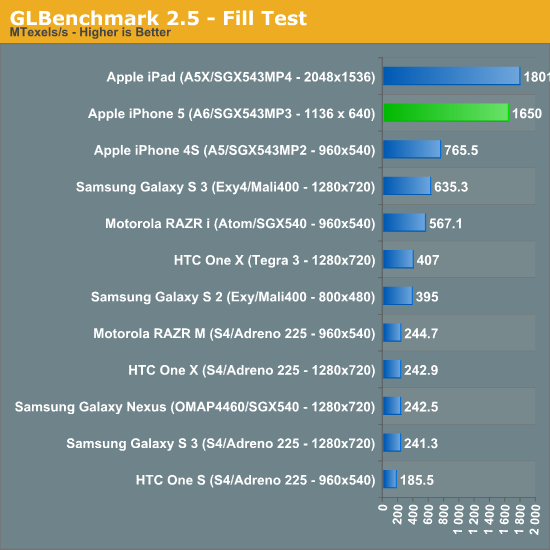
The iPhone 5 nips at the heels of the 3rd generation iPad here, at 1.65GTexels/s. The performance advantage over the iPhone 4S is more than double, and even the Galaxy S 3 can't come close.
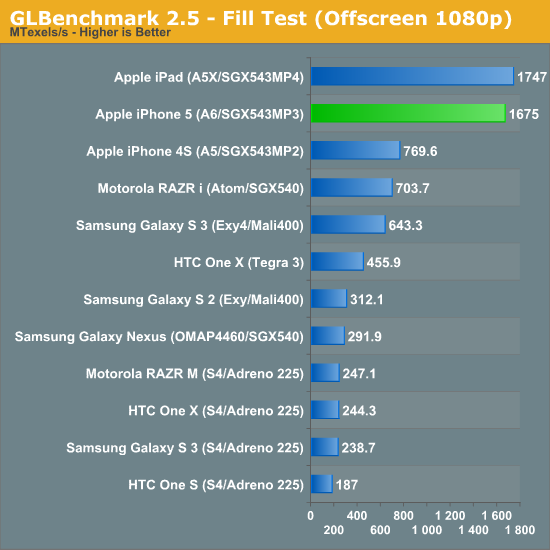
Triangle throughput is similarly strong:
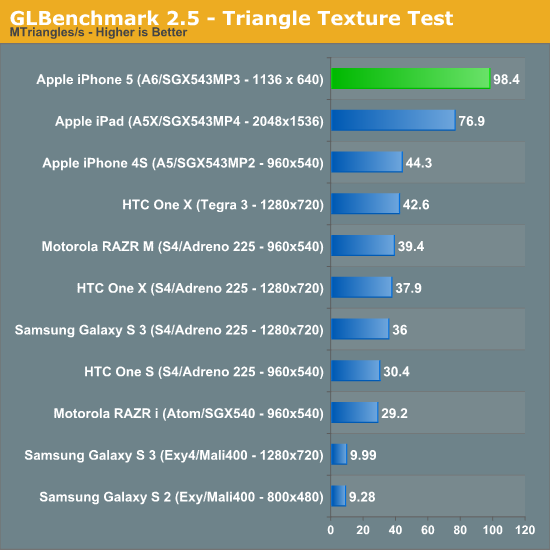
Take resolution into account and the iPhone 5 is actually faster than the new iPad, but normalize for resolution using GLBenchmark's offscreen mode and the A5X and A6 look identical:
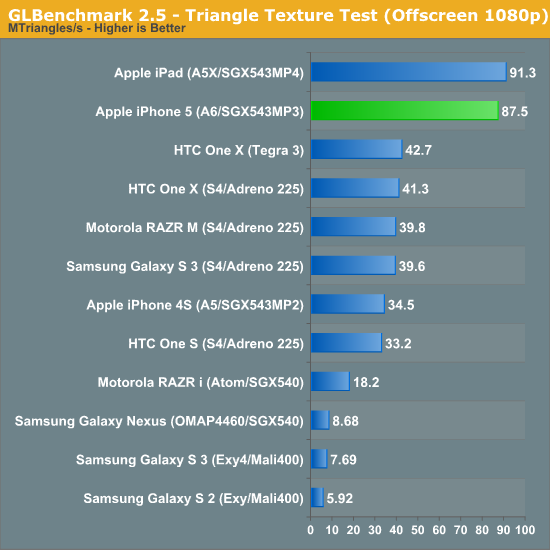
The fragment lit texture test does very well on the iPhone 5, once again when you take into account the much lower resolution of the 5's display performance is significantly better than on the iPad:
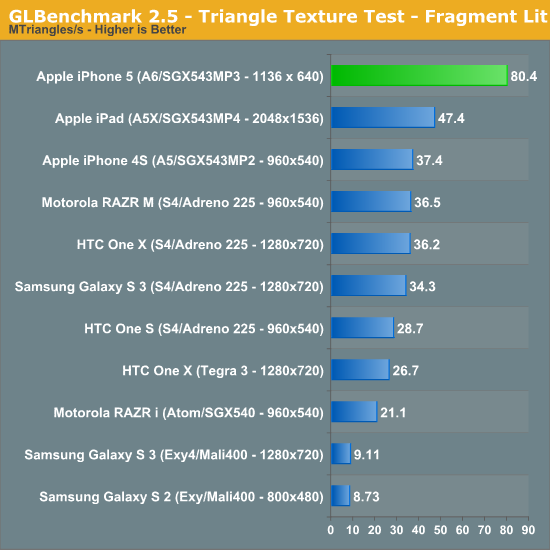
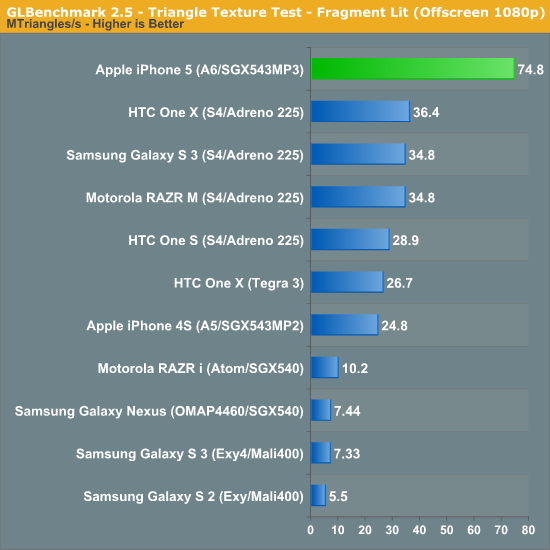
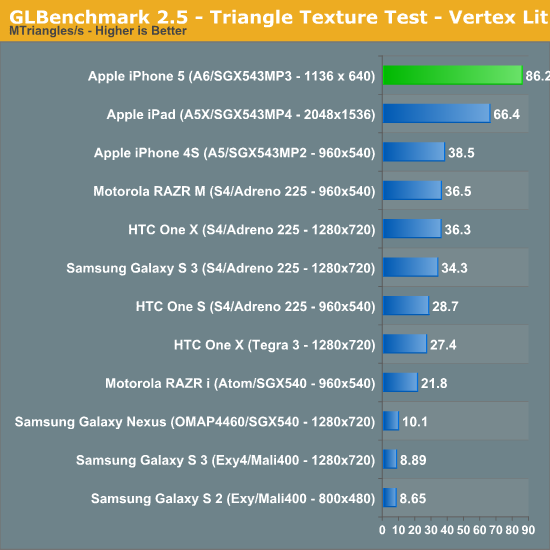
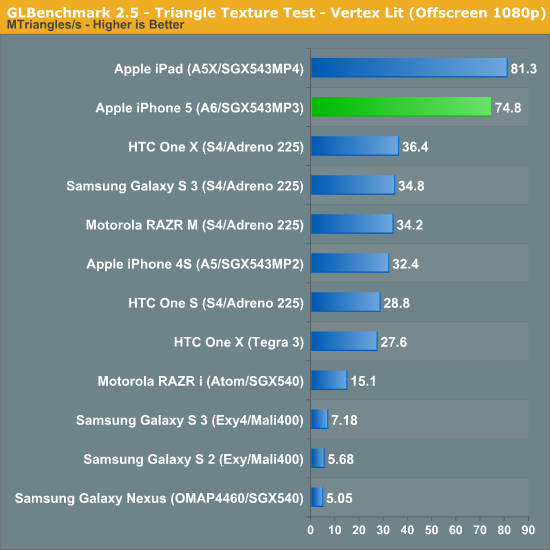
The next set of results are the gameplay simulation tests, which attempt to give you an idea of what game performance based on Kishonti's engine would look like. These tests tend to be compute monsters, so they'll make a great stress test for the iPhone 5's new GPU:
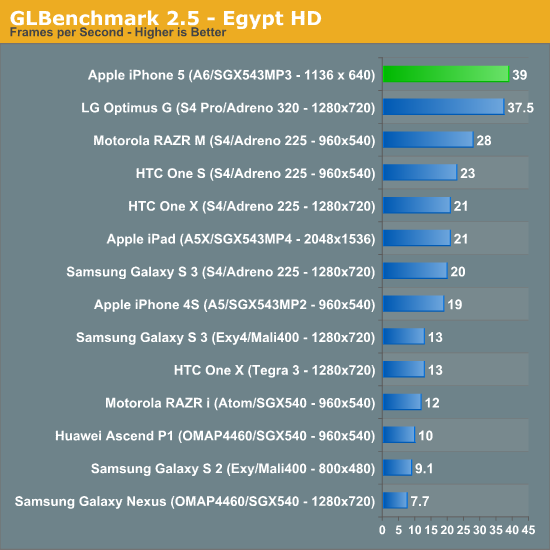
Egypt HD was the great equalizer when we first met it, but the iPhone 5 does very well here. The biggest surprise however is just how well the Qualcomm Snapdragon S4 Pro with Adreno 320 GPU does by comparison. LG's Optimus G, a device Brian flew to Seoul, South Korea to benchmark, is hot on the heels of the new iPhone.
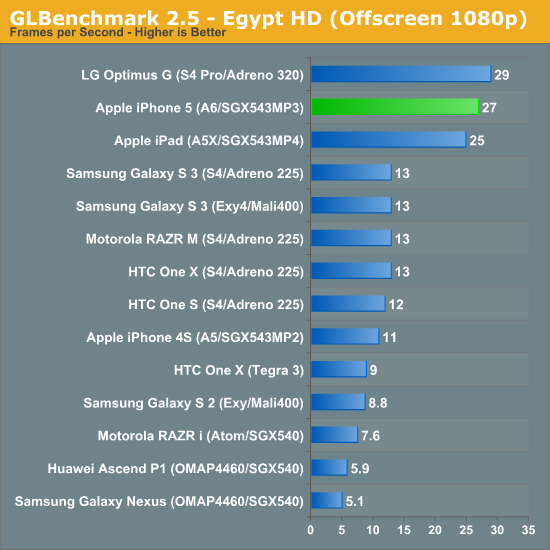
When we run everything at 1080p the iPhone 5 looks a lot like the new iPad, and is about 2x the performance of the Galaxy S 3. Here, LG's Optimus G actually outperforms the iPhone 5! It looks like Qualcomm's Adreno 320 is quite competent in a phone. Note just how bad Intel's Atom Z2460 is, the PowerVR SGX 540 is simply unacceptable for a modern high-end SoC. I hope Intel's slow warming up to integrating fast GPUs on die doesn't plague its mobile SoC lineup for much longer.
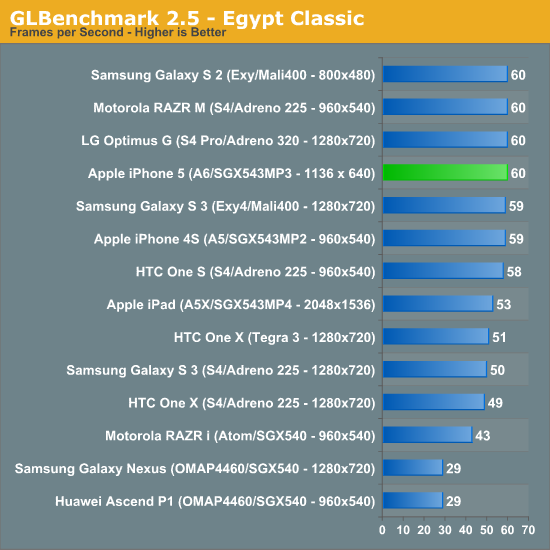
The Egypt classic tests are much lighter workloads and are likely a good indication of the type of performance you can expect from many games today available on the app store. At its native resolution, the iPhone 5 has no problems hitting the 60 fps vsync limit.
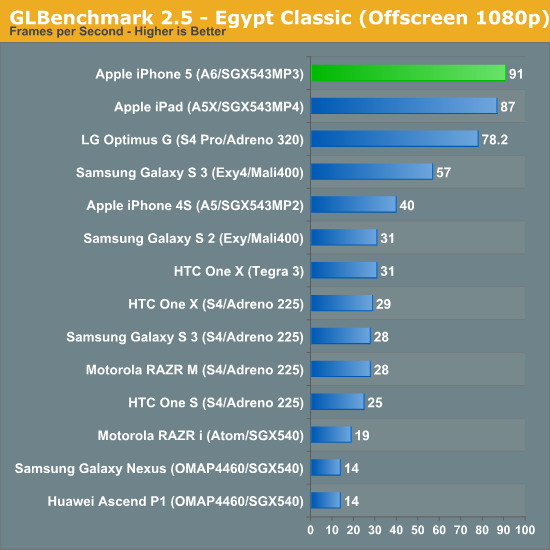
Remove vsync, render at 1080p and you see what the GPUs can really do. Here the iPhone 5 pulls ahead of the Adreno 320 based LG Optimus G and even slightly ahead of the new iPad.
Once again, looking at GLBenchmark's on-screen and offscreen Egypt tests we can get a good idea of how the iPhone 5 measures up to Apple's claims of 2x the GPU performance of the iPhone 4S:
Removing the clearly vsync limited result from the on-screen Egypt Classic test, the iPhone 5 performs about 2.26x the speed of the 4S. If we include that result in the average you're still looking at a 1.95x average. As we've seen in the past, these gains don't typically translate into dramatically higher frame rates in games, but games with better visual quality instead.


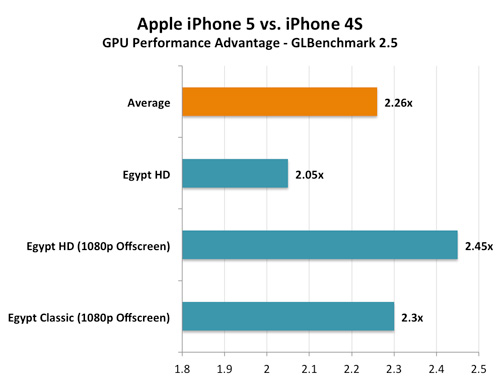








276 Comments
View All Comments
OldAndBusted - Wednesday, October 24, 2012 - link
"I'm not an apple product owner, and never plan to be"That's actually kind of sad. That no matter what the product, you can't even consider it if it comes from Apple.
SolidusOne - Saturday, October 20, 2012 - link
How can you write page after page about geeky nuances, many of which cannot be discerned without lab equipment, and not utter a single word about the device's music player quality? This model particularly, as other reviews have said it was inferior to 4s in audio quality. ??????phillyry - Sunday, October 21, 2012 - link
Sorry but are you serious or trolling?Google search reveals nothing about this.
If you're serious then Engadget has an article for you that compares the sound quality of iPhone 5, GS3, One X, etc. with basically no appreciable difference. http://www.engadget.com/2012/10/02/iphone-vs-rival...
mshdk - Sunday, October 21, 2012 - link
What is the name of the IM app shown in the review?mohit2805 - Sunday, October 21, 2012 - link
Why Apple never goes for an inbuilt radio? why just its own ipod, when there are so many radio stations to listen to for free?Krysto - Tuesday, October 23, 2012 - link
The new Chromebook, which has a dual core 1.7 Ghz Cortex A15 CPU, reaches 668 points in Sunspider. That's compared to the 900+ for Apple's A6.darkcrayon - Wednesday, January 2, 2013 - link
Comparing a chip in a laptop to one in a smartphone.. A laptop with terrible battery life (for an ARM device) at a that. Nice work. Let us know when Apple puts an Ax chip inside of a small laptop and then let's compare performance.eanazag - Thursday, November 1, 2012 - link
I live in MN and have been using the maps app in iOS 6 on an iPhone 4 and iPad 3. I have encountered no issues with it. In fact it has been a little more accurate than the GPS I have and Google previously. I am guessing that in more urban areas there is a larger difference.I would have liked to see some more features that my GPS has, such as current speed, estimated arrival time, and remaining total miles for trip.
If I'm going to complain, wish they would have included turn-by-turn on the 4.
Coffeebean20 - Saturday, November 24, 2012 - link
Wow great review, I got my iPhone 5 free And tested it. I came up with similar results. Great review, good job :)cpu_arch - Wednesday, November 28, 2012 - link
Your block diagram of Swift is inaccurate, not because I know the block diagram of the Swift CPU, but because it fails to describe the basic out-of-order execution pipeline of any modern CPU's. Hint: instruction re-ordering is in the wrong place in your diagram.Your measurements of branch prediction microarchitecture performance are not useful. The key measurement is mispredict rate.
Also modern branch prediction is a function of branch outcome of the branch in question and prior branches, not some multiply/divide mechanism which you describe in your article.